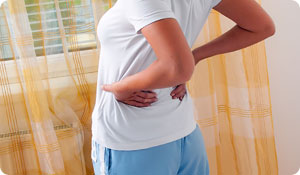
Millions of women suffer from menstrual back cramps every month. Unlike other types of muscular back pain, which go away and typically don't come back, menstrual back pain can be a frequent, unwelcome visitor.
Just like menstrual cramps, most menstrual back pain is caused by contractions of the uterus as it releases menstrual fluid. These contractions, while not as strong as the kind experienced during labor, can cause painful aching that lasts for days. The uterus is attached to back and pelvic muscles. When the uterus contracts or cramps, it pulls on all the surrounding tissues in the abdomen, pelvis, legs and back causing painful symptoms.
Some women experience menstrual back pain because of fibroids, non-cancerous growths that can develop on the outside of the uterus and between uterine muscle tissues. Fibroids are very common and not usually dangerous. If they grow on the back of the uterus though, they can press against the spine and back muscles and be quite painful. Birth control pills can sometimes reduce the size and growth of fibroids. Some women need surgery to remove extra large fibroids.
How to Relieve Menstrual Back Pain
Heat, over-the-counter non-steroidal anti-inflammatory pain medications, and exercise are usually enough to relieve the pain for most women.
- Ibuprofen and aspirin are widely recommended by gynecologists as the best pain and anti-inflammatory medications for blocking uterine and back cramps. Most doctors suggest you start taking these medications regularly (about 600 mg Ibuprofen every eight hours) a couple days before you expect your period to start and continuing for the first few days of your cycle. This short circuits the pain response, reduces inflammation and stops cramps before they start.
- Use a heating pad or soak in a warm bathtub to relieve back pain.
- Take a walk, do some yoga and practice resting for ten to fifteen minutes, several times per day in the knee-chest position. This position might tilt the weight of your uterus off your back and relieve your back pain. To start, put your hands and knees on your bed or yoga mat. Then, lower your chest to the mat and leave your hips in the air. Relax with your head on a pillow.
If these tips aren't effective, you might need prescription strength help from your doctor. Birth control pills are frequently prescribed to relieve all types of menstrual symptoms. They cause the uterus to develop a thinner uterine lining, which decreases menstrual flow and cramping in most women. Some women choose continuous-dose birth control pills to avoid having monthly periods altogether.
Some anti-inflammatory medications and pain medications are only available by prescription. Narcotic pain medications are sometimes prescribed for women whose menstrual cramps and back pain aren't relieved by anything else.
Talk to your gynecologist if your menstrual symptoms are causing an unusual amount of pain.





